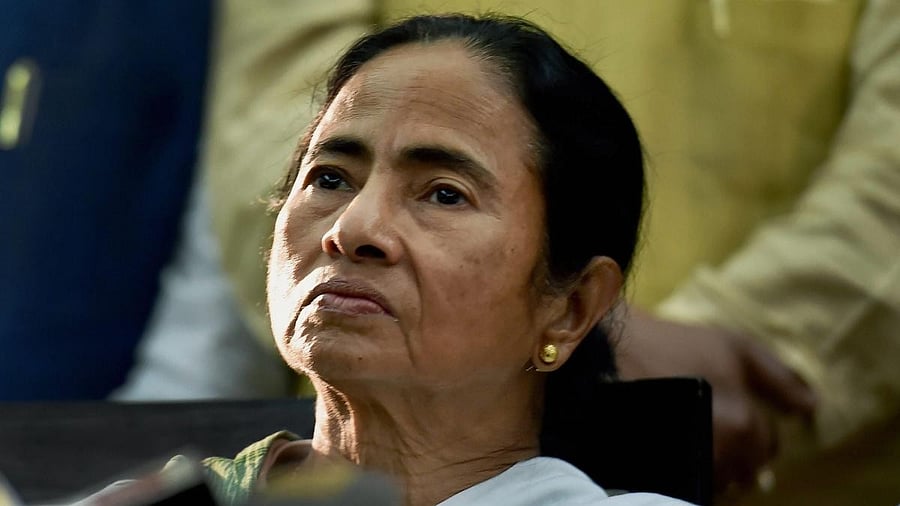
West Bengal CM Mamata Banerjee.
Credit: PTI File Photo
On August 14, in 300 intersections and rallying points across West Bengal, tens of thousands of women stepped out of their homes late in the night to reclaim their right to being safe at night. The original plan circulated on social media was to gather in three locations across the metropolis to demand justice for the trainee doctor of R G Kar Medical College and Hospital who was gang-raped and barbarically murdered inside a seminar hall on the premises.
Exasperated and impatient with the slow crawl of the investigation by a team of policemen and the odd actions of the college hospital principal, the protests are a measure of how women rate the current political order, presided over by the iconic Didi, Mamata Banerjee, chief minister of West Bengal. The present is not just dangerous at night for women; it is dangerous because the law and order machinery has become putty in the hands of a class of politicians who have neither conscience nor appear accountable to anyone, including Banerjee.
Caught off guard by the strength of the spontaneous protests, Banerjee has advanced the date for her political rally in which she will walk from one end of the city to another to reconnect with the masses. These walks have worked to her advantage in the past. Even the reluctant have felt appeased enough to give her the benefit of the doubt in politically sticky moments.
Her expectation is it will work for her this time, by co-opting her as a partner in the fight for justice for ‘Abhaya’, as the doctor-trainee victim has been popularly named. But she is unsure. The rally was originally planned for August 17; after the wildfire spread of protests mostly by women on August 14, Banerjee felt compelled to change the date to August 16.
The change in the schedule could be Banerjee’s tryst with destiny moment. If she can pull it off, which depends as much on her message as on the mood of the public, her political future may not be as bleak as it appears today.
The spontaneous protests were not just about the murder and gang-rape of the 31-year-old trainee doctor. These public gatherings were a measure of how angry people feel about a regime that has usurped the functions of the administration and the police, and given an entirely new meaning to the idea of ‘party-government’.
The cast of characters in the barbaric murder and gang-rape incident reveal the skeleton of party-government. The only perpetrator identified by the Kolkata Police, Sanjoy Roy, who is now in Central Bureau of Investigation (CBI) custody following an order of the Calcutta High Court, was employed as a ‘civic police’, the popular description of contractual civic volunteers who work with the police. He had access to every part of the sprawling R G Kar Medical College and Hospital complex, and was a man with clout over admissions. He also got on famously with the local police station to which he was attached to the point that motorbikes assigned to sub inspectors were routinely used by him. He reportedly had ‘connections’. So, apparently did the principal; he was removed because the protesting students demanded it and within hours he surfaced as principal of another medical college and hospital in Kolkata till he was sacked by the high court.
The network of connections of people in the state administration to contractual employees who obviously serve a purpose regardless of how low in the pecking order they may be is what the demand for justice really meant when the women took to the streets to reclaim the night. The principal’s attempt to deny what had happened, the way the victim’s parents were treated, and the public perception that the police was deliberately slipshod in its investigations are all elements that came together in the 300 or more rallies on August 14.
Public displeasure reflected in a public indictment framed as the demand ‘We want Justice’ is an unequivocal condemnation of the way in which Banerjee’s government works. It is a message that she has certainly read correctly.
It poses the most serious challenge to her authenticity as a leader, the one factor that connected her with women as voters and the masses, as their Didi. The narrative of the Opposition that includes the Bharatiya Janata Party (BJP), the Communist Party of India (Marxist)-led Left Front, and the Congress that Banerjee was running a government through a nexus of unscrupulous politicians, and power brokers-criminal and lumpen musclemen aided and abetted by the police and bureaucracy has dripped into public consciousness.
Everyday experiences of the excesses of the local Trinamool Congress (TMC) ‘netas’ and their teams have soured people’s lives. What redeemed the TMC for the voters, especially women voters, was the persona of Mamata Banerjee. A rift between women voters and herself is Banerjee’s worst possible nightmare; she needs them because her electoral success since 2009 in local body elections followed by the Assembly triumph of 2011 was largely crafted by women’s support and confidence in her leadership.
She has time till the next Assembly polls due in 2026 to repair and rebuild the connection with her support base. But she is weighed down by her past performance on the one hand and her evident failure to keep control over a wayward party of people on the make.
Shikha Mukerjee Is a Kolkata-based senior journalist.
(Disclaimer: The views expressed above are the author's own. They do not necessarily reflect the views of DH).